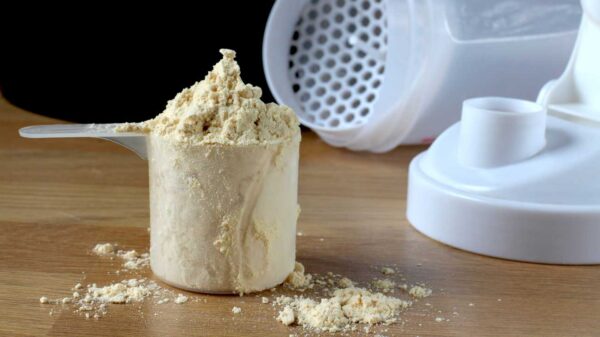A Complete Guide on How to Take Creatine in 2024
If you’ve decided to supplement with creatine, you need to know that there is a right way and a wrong way to do it. Find out what you need to know here.
Everyone who uses creatine seems to have advice on how to use it, often sharing their opinions without prompting, much like the helpful individuals at the gym who offer unsolicited advice on various exercises, from weightlifting to yoga poses.Simply acknowledge their input with a smile and gratitude once they’ve finished. Despite the widespread use of creatine, many individuals are not using it correctly. If you’re considering supplementation, it’s essential to gather comprehensive information and seek guidance from professionals such as your physician, trainer, or coach to customize your creatine regimen according to your objectives, lifestyle, and requirements.
“Typically, the loading phase involves taking 20-25 grams of creatine divided into 4 doses per day for a period of 5-7 days.”
Creatine loading
Loading is a popular starting method for creatine supplementation, known for its direct and rapid results. The aim is to saturate the muscles’ energy stores quickly before transitioning to the maintenance phase, where you sustain the achieved levels. Typically, during the loading phase, individuals consume 20-25 grams of creatine spread across four doses daily for 5-7 days. Following this, they enter the maintenance phase, taking 3-5 grams daily for continued supplementation.
In the initial front-loading phase, some individuals opt for larger, less frequent doses, which could lead to digestive discomfort like bloating, gas, or diarrhea. However, most find that dividing smaller portions into 4-5 doses per day works best, with similar results regardless of how they distribute it. Whether during front-loading or throughout creatine supplementation, adequate hydration is crucial.
Creatine cycling
Supplement cycling is a common practice to sustain maximum effectiveness and prevent tolerance buildup. Typically, one follows a regimen of taking a specific supplement for a set period, then discontinues use for another period before resuming. During the non-supplementing phase, it’s believed that the supplement is entirely eliminated from the body. However, since creatine supplementation aims to maintain saturated energy stores, traditional cycling would be counterproductive. The goal throughout creatine supplementation is to ensure its continual presence in the system.
Daily low-dose supplementation
The simplest and least complex method of creatine intake involves consuming 3-5 grams daily without the need for front-loading or transitioning to maintenance phases. By adopting this approach consistently throughout your supplementation, you can potentially avoid digestive discomfort associated with larger doses. Additionally, you may experience gradual improvements in muscle mass, strength, and recovery speed. No need to fret; you’ll achieve equivalent results. Instead of experiencing significant changes within two weeks, you’ll notice steady progress of similar magnitude over about a month. While rapid muscle growth might briefly attract attention in the weight room, there’s value in the slow and steady approach, even when it comes to building muscles.
This research involving 31 male participants suggests that maintaining consistent intake of smaller creatine doses over time yields similar effectiveness in increasing tissue levels compared to the traditional loading process with higher doses.
Keep it consistent
Consistently taking creatine is crucial as it replenishes muscle energy stores daily. If you decide to discontinue supplementation, it’s safe to do so, but muscle creatine levels begin to decline approximately two weeks after stopping. Essentially, gains in muscle size, endurance, performance improvements, and rapid recovery will gradually diminish.
Within 4-6 weeks, any additional creatine from supplementation will be fully eliminated from your muscles, returning your body to its natural production of 1-2 grams of creatine per day. If you’re worried about the duration of your supplementation, a study involving 26 athletes who have been supplementing with creatine long-term suggests that this practice does not cause any negative health consequences.
What if you miss a day?
Occasionally skipping a day of creatine supplementation isn’t a significant concern, as the consistent daily practice maintains muscle energy stores fully saturated. Today’s workout doesn’t hinge on the creatine intake for that day. If your muscle energy stores are already saturated and you miss a day or two, it’s not a cause for concern. The key is to promptly resume your daily supplementation routine to avoid breaking the habit. Your increased creatine levels will persist for approximately 4-6 weeks, eliminating the need for another loading phase. Following this period, you’ll notice a return to your pre-supplementation state, characterized by lower creatine levels, reduced muscle size, fewer repetitions, and slower performance times.
When should you take creatine?
Determining the ideal timing for creatine supplementation lacks a definitive answer. While one study suggests post-workout supplementation offers an advantage, many experts and athletes hold differing opinions. Those who supplement before workouts, in the morning, or at night often cite their own research to support their preferred timing. However, the consensus emphasizes the significance of daily consistency in supplementation, which is deemed equally important regardless of timing.
What should you take creatine with?
Creatine, a tasteless powder provided with a 5-ounce scoop, can be easily mixed with any beverage and consumed daily. Opinions vary widely on what it should be paired with. Some suggest better absorption when taken with carbohydrates like fruit, fruit juice, vegetable juice, or starches, while others advocate for pairing it with protein for optimal results. Alternatively, some purists advocate simply mixing the powder with water and drinking it as is.Some creatine users are less strict and might opt to intermittently consume it through energy drinks that contain smaller doses. However, the overall impact of these minimal amounts of creatine remains uncertain and requires further research for clarification.
What is creatine?
Creatine, an amino acid, is predominantly stored in the muscles of the body, where it serves as an energy source. The majority of the body’s creatine comes from dietary sources like seafood, red meat, and pork.
An artificial form of creatine has gained immense popularity as a supplement among athletes and bodybuilders. It’s known to enhance lean muscle mass, boost strength, endurance, and accelerate recovery after workouts, easing fatigue and soreness. Initially, this synthetic creatine was utilized to enhance speed and power among elite Olympic sprinters.
Bodybuilders, weightlifters, and athletes from various disciplines have contributed to making it one of the most sought-after sports supplements available today.
How does creatine work?
The primary function of creatine in the body is to produce energy. During exercise, energy is generated through the utilization of Adenosine Triphosphate (ATP). As ATP is used, it loses a phosphate molecule and transforms into Adenosine Diphosphate (ADP). Creatine has the ability to replenish ADP, converting it back into ATP, thus ensuring a continuous supply of high energy for rapid and explosive movements. Essentially, higher levels of creatine in muscle energy stores allow for increased exertion. This surplus energy facilitates lifting heavier weights, enduring longer runs, sprinting at greater speeds, training more intensely, and developing greater lean muscle mass than previously believed achievable. Moreover, you’re likely to experience faster recovery from muscle fatigue and soreness. However, it’s crucial to recognize that achieving these benefits requires considerable effort on your part. Creatine supplements alone won’t produce results – your dedication and hard work are essential.
Potential side effects
When using creatine supplements, few side effects are typically reported. In the initial front-loading phase, some individuals may encounter digestive discomfort, nausea, or diarrhea due to the higher doses, though these symptoms usually dissipate rapidly. Additionally, some may experience temporary water retention during this phase, which also tends to resolve quickly.
Is creatine safe?
Although creatine is generally considered safe when used as directed, individuals with pre-existing kidney conditions, as well as pregnant, attempting to conceive, or breastfeeding individuals, should refrain from using creatine supplements.
According to the International Society of Sports Nutrition (ISSN), regulations or discouragement of creatine use by government bodies and sports organizations might endanger athletes, considering the numerous potential health advantages associated with its consumption.
As always, it is best to consult your physician or healthcare provider when adding supplements to your own protocol.
Related






















































